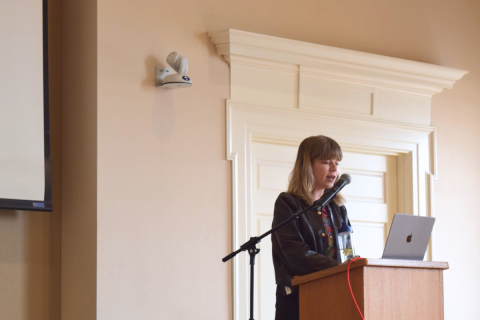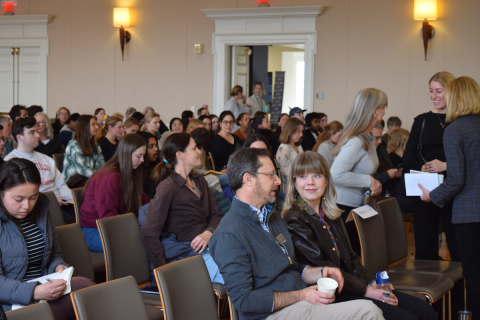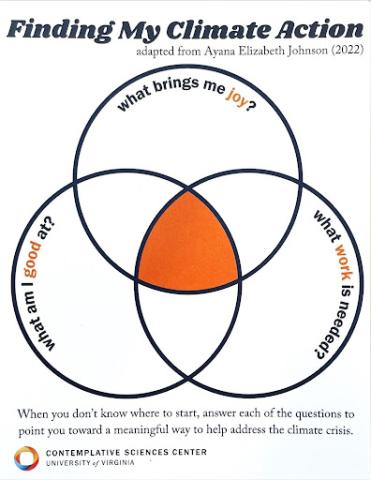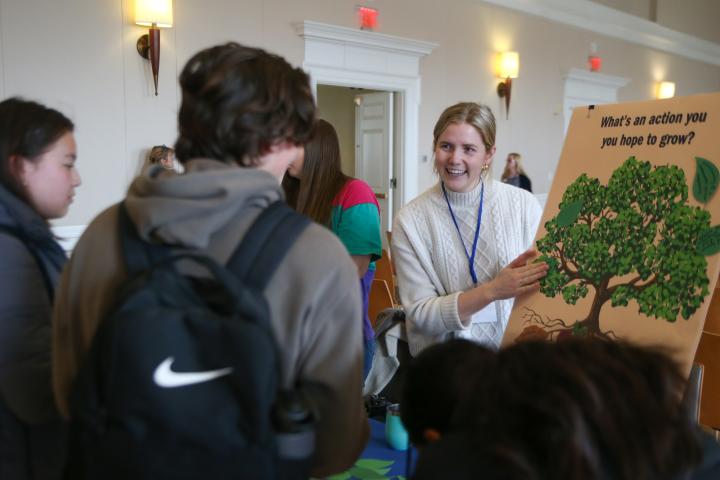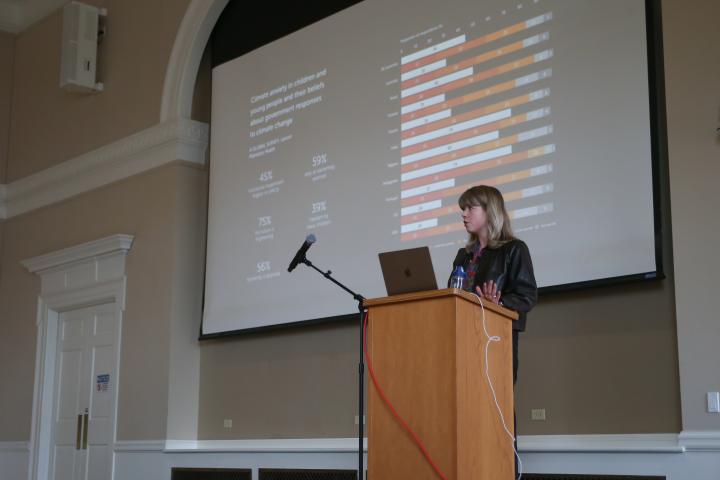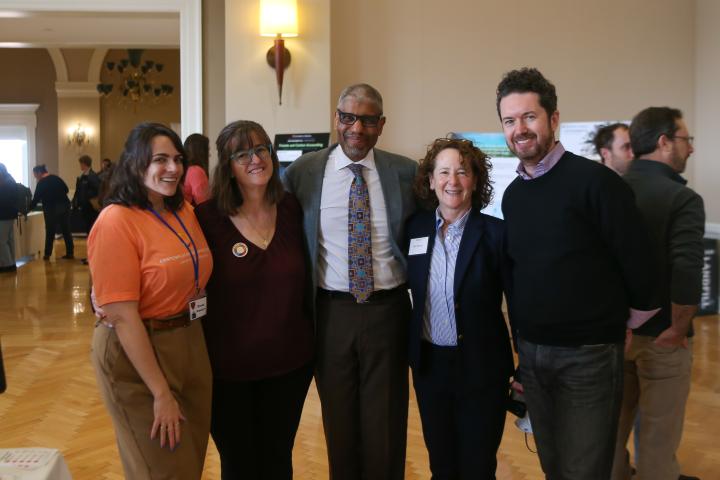Britt Wray's talk captivated an audience of nearly 200 UVA faculty, students, and staff eager to hear about ways to transform climate anxiety to climate action and hope.
Almost 200 eager listeners of all ages packed UVA’s Newcomb Hall Ballroom on February 22 to hear Britt Wray speak on climate anxiety and ways we can lean into those feelings and become powerful stewards of the planet.
The Stanford researcher and author of Generation Dread took us on a riveting journey through the research on climate anxiety and its antidotes. Articulate, compassionate, and at times humorous, 45 minutes later she gracefully landed us on the shore of hope for a brighter future where we can thrive. Wray drew upon many schools of thought and spiritual lessons in her work, and encouraged the audience to take what the Buddhist’s call “right action” to build a brighter future. Below is a recap of the main takeaways.
Psychological impacts of climate change deserve our attention
The struggle to find agency and purpose amidst the emotional heaviness and grief of climate change is not easy and not yet validated in our culture, Wray pointed out.
We cannot dismiss the emotional toll climate change takes on us as humans. Though the physical impacts are tangible, real, and visible, the emotional toll is often more difficult to see from the outside. Wray’s research has revealed that the psychological impacts of climate change actually far outweigh the physical impacts by a factor of 40 to 1. Lancet Planetary Health published a paper by Wray and co-authors on the findings from a global survey which found that 45% of youth are so worried by climate change that it affects their daily living, and 75% call the future frightening.
Thus we find ourselves in a vicious cycle where we learn more about climate change impacts, which leads to fear and anxiety, overtaking our ability to take any meaningful action. We must turn that vicious cycle into a virtuous cycle, where we can rebound and reset. This can help us find strength to take climate action for the benefit of the environment and our mental health. We must, Wray said, “maintain a full cup” so we can have the internal will and emotional/mental reserves to act.
Speaking to the older generations in the audience – professors, teachers, parents of young people suffering from climate anxiety through a range of negative emotions from worry to dread–Wray voiced the collective feelings of many young people who have feelings of “moral injury” and the “culture of uncare.” Young people feel adults and leaders have failed them, that they have been lied to by government officials, and this leads to feelings of futurelessness.
Okay, climate anxiety is real, but what do we do about it?
How do we simultaneously live with fear of the future without being overtaken by it? That was the question that set Wray on her research and writing journey, culminating in her book Generation Dread. What set of human characteristics create resilience and the ability to avert overwhelm and forge on? According to Wray:
1) We must shift our vocabulary. Climate anxiety is NOT pathological. It’s an important and appropriate response to a real existential threat to the human race. She urged the use of the term climate compassion. After all, when that which we love intensely is threatened, of course we show care and compassion and have an urge to save it.
2) We must feel these difficult emotions. Caroline Hickman, a climate-aware psychotherapist, lecturer, and researcher at the University of Bath, writes that fear and anxiety aren't inherently bad, but we need to be strong enough to tolerate the anxiety. When we suppress these emotions, they persist and eventually inhibit our ability to function. This can lead to paralysis.
3) Self-care is essential. As poet Audre Lorde so eloquently writes, “Caring for myself is not self-indulgence, it is self-preservation.” Mindfulness can build the mental and emotional resistance required to hold the anxiety and grief within us (and others) with compassion. What we focus our energy on grows, and if we work towards strengthening our internal reserve and presence of heart and mind, we will be able to take action and focus on the world we want to create.
Wray listed practical ways to practice self-care in the midst of climate anxiety, including:
- Mindfulness and contemplation practices
- Gratitude
- Connecting with nature
- Eating and sleeping well
- Yoga, somatic work
- Journaling
- Physical activity
- Breathing exercises
- Connecting with friends, family, ancestors
- Working with spiritual leaders
- Practicing good boundaries between climate work and personal life
4) Community builds resilience
Wray’s research uncovered the crucial importance of community in helping people bounce back after jarring events such as extreme weather. A proactive example she gave was participating in a beach cleanup: doing something good for the environment (physical) connects us with others and builds a sense of community (mental/emotional).
In the United States, there is an epidemic of loneliness and isolationism, which underscores the importance and co-benefit of taking climate action as part of a group. This bodes well for UVA students as the University has over 35 groups that provide an outlet for action and community at the same time.
5) Keys to retaining hope
Dr. Chan Hellman is an expert on hope. According to Hellman, hope is a mindset based on goals, pathways, and willpower. Wray shared that climate doomerism is a defense mechanism that can block both pathways and willpower.
To fight against this, Dr. Ayana Johnson’ has a powerful tool for recapturing hope: the three circle Climate Venn Diagram. The diagram can help isolate what we as individuals need to do in regard to the climate crisis. It allows us to find meaningful climate action that is fun, and it encourages us to use our strength and skills for producing positive change.
Resources
Finally, Wray shared a rich trove of resources, such as Good Grief Network, Climate Cafes, Climate Awakening, and the Climate Psychiatry Alliance. Particularly for educators, the Existential Toolkit can be a key resource, complete with readings and examples of student work. Climate-aware therapy is also valuable as it recognizes the fact that climate change is not just a pressing science issue but also an emotional and psychological issue.
Wray concluded with a famous Rumi poem, “The Guest House.” The poem encourages the reader to allow difficult emotions to be, as honored guests in the home of the body.
Wray received resounding applause and many in the audience provided reflections of gratitude. Her clarity, passion, and knowledge were a welcome breath of fresh air into the sometimes heavy bog of climate action and activism.
As an intern for Office for Sustainability newly enmeshed in the work of climate activism and a seasoned environmental advocate and communicator, we left with a renewed sense of hope and, more importantly, tangible tools to keep active, engaged, and able to ride the ups and downs of working in the climate solutions space. Yet anyone, whether as a frontline health care worker, public policy maker, or social justice nonprofit, can use the same tools.
“People say the work of advancing climate solutions is a marathon,” said Wray. “But it is not a marathon, it’s a relay. We can pass the baton to someone else so we can rest, and we can take the baton back when we are ready again.”
Share with us your favorite quote, moment, or resource at [email protected]! Check out the image gallery of the event below.
--Duha Aykan, UVA Office for Sustainability Intern (‘27) and Teri Strother, UVA Office for Sustainability Associate Manager of Communications
More Climate Anxiety Resources
This event was made possible through a collaborative partnership between UVA's Environmental Institute, Contemplative Sciences Center, Public Pathways Program, and Office for Sustainability.


